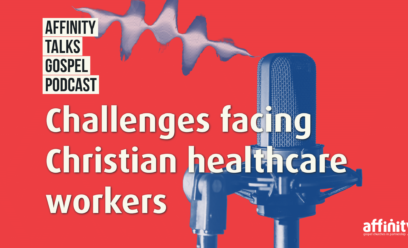Assisted Suicide and Euthanasia: A Dangerous Path to Go Down

The latest issue of Affinity’s Social Issues Bulletin is out now. It is free to download, as are all previous editions. In the current edition two members of Care Not Killing report on further moves to legalise assisted suicide:
Assisted Suicide and Euthanasia: A Dangerous Path to Go Down
Developments in the UK and Experience Overseas
Having been rejected multiple times by Parliamentarians and judges, encouraging assisted suicide (when the patient self-administers lethal drugs) and euthanasia (when a doctor administers the lethal drugs to a patient) remain illegal in the UK – but activists continue to push for a change in the law. In May, a new bill was introduced in the House of Lords by Baroness Meacher. The ‘Assisted Dying Bill’ is promoting assisted suicide for terminally ill adults with a prognosis of six months of less to live.
The passive language is a crucial tactic in the push for a change in the law: ‘assisted dying’ has no meaning in law and its definition is malleable. What is being referred to changes depending on who you’re taking to and in which country you reside. In Ireland and New Zealand, the term includes euthanasia, but here in the UK it is used by Dignity in Dying and their allies to refer to assisted suicide for those thought to be terminally ill. Other British groups, such as Humanists UK or My Death My Decision (MDMD), include both assisted suicide and euthanasia in their understanding of the term.
Veteran campaigner Michael Irwin, now of MDMD, observed in the course of an interview with The Guardian this year that:
the word ‘suicide’ was effectively forbidden in mainstream right-to-die activist circles – sick patients felt affronted by it, and political advocates wanted to detach their movement from it – but Irwin said he wanted to ‘reclaim’ suicide as a ‘rational and positive act when a mentally competent, very elderly individual has carefully considered the main pros and cons for wanting to stay alive.’
He, like many ‘assisted dying’ campaigners, sees assisted suicide for terminally ill people as an inadequate first step, and looks ahead to expansion in the name of inclusion with the law being expanded to include euthanasia for non-terminally ill people and elderly people whose lives are deemed to be ‘complete’.
The disability rights advocacy group Not Dead Yet made clear their horror at the Meacher Bill stating:
For essential support to become merely the alternative option to assisted suicide terrifies us. That is why no organisation of terminally ill or disabled people has sought a change in the law. We need help to live – not to die. That means investment in palliative care, pragmatic solutions to social care provision and continued financial support for our world-class NHS. These are the issues our parliamentarians should be concentrating on, rather than the Pandora’s Box of assisted suicide which might help the few, but at the expense of the many.
The Bill will be debated in the Autumn – by which time it will not be alone.
In June, Liberal Democrat MSP Liam McArthur announced his intention to bring a similar bill before the Scottish Parliament. His bill would legalise assisted suicide for terminally ill, mentally competent adults in Scotland, and a consultation – the first stage of the legislative process – is expected to commence in the Autumn.
Care Not Killing considers that it is particularly insensitive to bring forward these bills at a time when so many people have lost loved ones as a result of the Covid 19 pandemic. People with disabilities have again been to the fore in questioning the need for and safety of such a law. Pam-Duncan Glancy, a wheelchair user newly elected as a Labour MSP, tweeted:
I am deeply worried about this. Disabled people do not yet enjoy our right to live equally. I’d far rather we had a right to live enshrined in law, long before we have a right to die. Until all things are equal, this is dangerous for disabled people.
Oregon
The Meacher Bill (and likely the as-yet unpublished McArthur Bill) is modelled on practice in the US State of Oregon, which legalised assisted suicide for those thought to have six months or less to live in 1997. How does it work there?
A total of 245 Oregonians died by assisted suicide in 2020; that figure represents a 28% jump from 191 in 2019, and is more than nine times as many as died in 2000. Oregon is a comparatively small state with a population of 4.2 million; those 245 deaths would extrapolate to some 3,880 for a UK-sized population.
We are often told that assisted suicide can be closely monitored, yet of the 370 prescriptions for lethal drugs issued in 2020, the ingestion status is unknown in 80 cases; we don’t even know if 44 of those are still alive.
Advocates of assisted suicide who try to bat away warnings of incremental extension (or the slippery slope) to include other conditions can no longer claim that the Oregon law remains unamended. The law in Oregon now provides an exemption to the statutory waiting periods for patients expected to live fewer than 15 days from the time of their first oral request for medication. The Oregon Health Authority annual report for 2020 notes that 75 patients (20%) were given exemptions.
It states also that ‘a total of 142 physicians wrote 370 prescriptions during 2020 (1-31 prescriptions per physician)’. The clarification that ‘79% of physicians wrote one or two prescriptions’ really only draws attention to the fact that 21% wrote more, with at least one prescribing lethal cocktails every 11 or 12 days. The gravity of this fact is reinforced by the report noting that some assisted suicides were approved by doctors who had known the patients in question for less than a week. Only 3 out of the 245 who died were referred for psychological or psychiatric evaluation.
Assisting the suicides of those who have clinical depression in Oregon is particularly concerning. Studies show that 25% of people with terminal illness are clinically depressed. In Oregon, only 2-3 patients per year who seek an assisted suicide are referred for psychiatric evaluation. The number of such referrals has stayed more or less static since the law was introduced. Thus in 1998, when 16 people were helped to die by assisted suicide most of those with clinical depression were referred for psychiatric assessment. By 2020, however, some 60 people or so should have been referred for psychiatric or psychological assessments as opposed to the 3 referrals which in fact occurred.
Another concern about Oregon is the fact that the suicide rate in that state has increased by 33% since 2001. There is some evidence to suggest that the legalisation of assisted suicide has contributed to this increase in the suicide rate among the general population. That should not come as a surprise as the rationale behind the drive for legalising assisted suicide or euthanasia is a belief in personal autonomy as an absolute. If that is the motivation, then why would arbitrary limits be placed on who can and cannot have assistance to commit suicide? Unsurprisingly, the suicide rate in Oregon is consistently higher than the US national average; by over 30% in 2019.
The annual report for 2020 notes that five who died suffered complications, including difficulty ingesting and a seizure; a footnote quietly adds that ‘information about complications is reported only when a physician or another health care provider is present at the time of death’. This goes some way to explaining why, in more than 70% of assisted suicides last year, we don’t actually know if the patients suffered complications.
Oregonians who died by assisted suicide in 2020 took up to eight hours to die after ingesting medication; the range extended to 47 hours in 2019, and to 104 hours previously. Again, it is worth noting that we don’t know how long death took to occur in almost half of 2020 cases.
While cancer remained the most common underlying illness (66%), this was down significantly from the 76% average across 1998-2018. Five of those dying in 2020 (2%) were living with ‘endocrine/metabolic disease (e.g., diabetes)’, while 9 (3.7%) cited ‘other illnesses’ including ‘arthritis, arteritis, blood disease, complications from a fall, kidney failure, medical care complications, musculoskeletal system disorders, sclerosis, and stenosis’. Oregon’s law has only been formally extended once (as noted above), but officials admit freely that they now consider patients to be eligible if they refuse otherwise life-sustaining treatment, without formal amendment of the legal requirement that ‘an incurable and irreversible disease that has been medically confirmed and will, within reasonable medical judgment, produce death within six months.’
Even without the loosening of the terminal illness requirement, predicting death within six months is widely considered to be more of an (unreliable) art than a science, and once again, patients lived far longer than six months – some for almost three years (1,080 days). Health officials are clearly sensitive to this as the report now notes how many ‘outlived 6-month prognosis’ – eight in 2020. This artificial figure obscures a fundamental point: the six-month prognosis concerns the time left to patients before their underlying illnesses cause death, and we cannot know how many of the 245 would have lived perhaps longer than six months had their suicides not been assisted.
Once again, a majority of participants cited a fear of being a ‘burden on family, friends/caregivers’ (53.1%), with the most-cited factors remaining existential and social: ‘less able to engage in activities making life enjoyable’, ‘losing autonomy’ and ‘loss of dignity’. ‘Inadequate pain control, or concern about it’ was cited by fewer than one in three, while 15 were driven at least in part by ‘financial implications of treatment’.
The annual reports from Oregon, year after year, serve to tell a story of rising numbers of deaths in a poorly monitored system, based on fears that have little to do with the bounds of medical ability and everything to do with how we support people under great strain.
Canada
Since rebranding after seven decades as the Voluntary Euthanasia Society, ‘Dignity in Dying’ present their proposals as the only show in town, and seek to stymie discussion of the lessons of any non-Oregon model of ‘assisted dying’. However, the Cross-Party Group of MSPs at Holyrood supporting a law change have heard at length from Canadian experts and practitioners.
Canada’s federal law allowing euthanasia and assisted suicide or ‘Medical Aid in Dying’ (MAiD) where an individual’s death was reasonably foreseeable passed in 2015, and took effect in summer 2016. In the remainder of that year, there were 1,015 deaths under the new law. In 2020, 7,595 cases of MAiD were reported, representing 2.5% of all deaths in Canada. Overall there has been a 648% increase in MAiD deaths in the first five years of the operation of the law and the total number of such deaths reached 21,545 by the end of 2020.
In 2019, the Canadian Hospice Palliative Care Association (CHPCA) and the Canadian Society of Palliative Care Physicians (CSPCP) released a joint statement noting that:
Less than 30% of Canadians have access to high quality hospice palliative care, yet more than 90% of all deaths in Canada would benefit from it. Despite this startling discrepancy, access to hospice palliative care is not considered a fundamental healthcare right for Canadians. In contrast, MAiD has been deemed a right…
Too many Canadians have seen this reflected in their own lives: instances where those requiring expensive care have seen this cut or refused, but have been offered the drugs to kill themselves. Cases like Roger Foley from Ontario who suffers from a neurological disease. He recorded hospital staff offering him a ‘medically assisted death’, despite his repeated statements that he did not want to die and wanted to return to his home.
On 11 September 2019, a Quebec Superior Court judge ruled invalid the Criminal Code requirement that a natural death be ‘reasonably foreseeable’, and also the Quebec law requirement that people must ‘be at the end of life’, before being eligible for euthanasia. ‘An Act to amend the Criminal Code (medical assistance in dying)’ received Royal Assent on 17 March 2021, and as well as removing the terminal illness eligibility criteria included requirements: that Justice and Health Ministers ‘cause an independent review to be carried out’ regarding extension of MAiD to ‘persons who have a mental illness’, with a report required within a year; and that a Joint Committee of both Houses of Parliament also present a report within a year regarding the extension of MAiD to ‘mature minors, advance requests, mental illness’.
Ahead of the law’s extension, a 2019 Parliamentary report found that under the original law, 6,465 people were expected to die by MAiD in 2021 – 2.2% of all deaths – with net healthcare savings of $86.9m. Given the actual number of MAiD deaths in 2020, this is likely a significant underestimate. The report predicted that amending the law would add 1,164 deaths in the first year alone, leading to increased healthcare savings in 2021 of $149m – almost £87m.
Implications for the UK
Academics in the UK have argued ‘that the economic costs of denying assisted dying should not be ignored; they should not be the key driver of any legal change, but it would be irresponsible not to consider them.’ We are all familiar with reports of ‘postcode lotteries’ when it comes to access to treatment, and it would be an expression of wilful naiveté to suggest the financial considerations would not interact with legalised assisted suicide as the age of recession and austerity is succeeded by the almost unfathomable economic hangover of Covid.
All of these laws require the participation of doctors, who assess and then prescribe or even administer lethal medication. There is a battle going on within the medical profession at present with assisted suicide and euthanasia campaigners attempting to persuade British medical bodies to adopt positions of neutrality. However, doctors working most closely with patients approaching the end of their lives remain overwhelmingly opposed to a change in the law.
The Royal College of Physicians (RCP) conducted a membership poll in 2019. Opposition to assisted suicide remained the most favoured stance (43.4%), and more than 80% of palliative care physicians wanted the College to remain opposed. Nevertheless, an unprecedented supermajority requirement saw the Council of the College adopt neutrality as the RCP’s new position.
The Royal College of General Practitioners (RCGP) reaffirmed its opposition to assisted suicide in February 2021, following a consultation of members in which 47% opted for the status quo and 40% expressed support for a position in favour of assisted suicide. Just 11% opted for neutrality.
The British Medical Association (BMA) published the results of its own membership consultation in October 2020. The BMA poll showed that:
· 70% and 79% of palliative medicine doctors wanted the BMA to stay opposed to assisted suicide and euthanasia respectively. Personal opposition was higher at 76% and 83% and those unwilling to participate sat at 76% and 84%.
· Those most supportive of change were those not actually currently practising medicine: medical students (9% of respondents) and retired members (11% of respondents) were (respectively) 53-20 percent and 50-27 percent in favour of BMA support for a law change.
· Only 73% of those wanting the BMA to support assisted suicide, and only 68% of those personally in favour, said they would be willing to participate in the process if legal. Similarly, only 69% of those wanting the BMA to support euthanasia, and only 64% of those personally in favour, were willing to participate.
Of course, some doctors make no bones about their enthusiasm and willingness to participate. We have already noted that in Oregon, some doctors are approving patients they hardly know for assisted suicide every other week, while activists like Michael Irwin – struck off the medical register after attempting to assist a friend’s suicide – favours assistance being available in a swathe of situations. Asked in 2016 about those ‘suffering from depression, constant migraines or a long-term condition like asthma’, Irwin said: ‘Severe asthma is a serious medical condition. If a competent adult is suffering unbearably from this – for a very long period of time – then that individual might have to consider doctor-assisted suicide – it would have to be a joint decision between the patient and the doctor.’ Once the principle is in place, all barriers of diagnosis and prognosis are arbitrary, porous and open to challenge.
Campaigners focus on opinion polling which regularly appears to indicate public approbation for ‘assisted dying’. But claims based on polls have to be taken with a ‘pinch of salt’ as the results often depend on what leading questions have been asked. Other polls show significant levels of public concern.
· A February 2019 poll showed that 51% of respondents ‘would be concerned that some people would feel pressurised into accepting help to take their own life so as not to be a burden on others’ if assisted suicide were legal (with only 25% disagreeing).
· A September 2015 poll showed that 86% of respondents ‘were concerned… NHS managers or politicians would prioritise assisted dying over end-of-life care to save money’.
· A November 2014 poll showed that 58% of respondents agreed that ‘if the law is changed so that people are able to be given lethal drugs to end their life prematurely, it will be impossible to make the system completely safe from abuse by unscrupulous relatives or others who could influence the process’ (just 18% disagreed).
· Finally, a July 2014 ComRes poll saw support for euthanasia drop below 50%, level with opposition, when the five main arguments against it were heard
This is a debate which too often generates more heat than light, but the 2015 Commons debate on an ‘assisted dying’ bill demonstrated that when undecided MPs heard from experts and considered the evidence, it became clear that good intentions could never override the dangers of legalising assisted suicide. We have seen that such laws are uncontrollable, unethical and unnecessary and we will continue to fight for the true dignity and choice of fulsome support for the living and access to care for the dying.
Dr Gordon Macdonald (Chief Executive, Care Not Killing) and Daniel Cuffe (Campaign Manager, Care Not Killing)
(This article was originally published in the Affinity Social Issues Bulletin for July 2021. The whole edition can be found at www.affinity.org.uk)
Stay connected with our monthly update
Sign up to receive the latest news from Affinity and our members, delivered straight to your inbox once a month.



